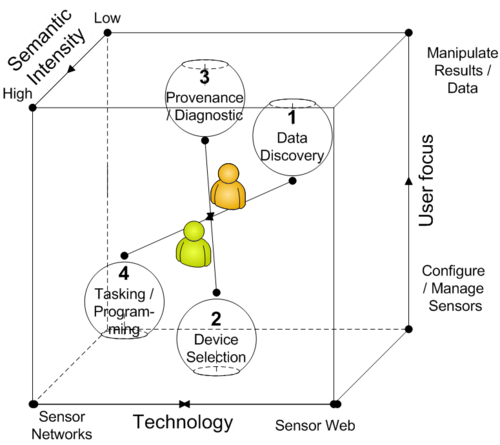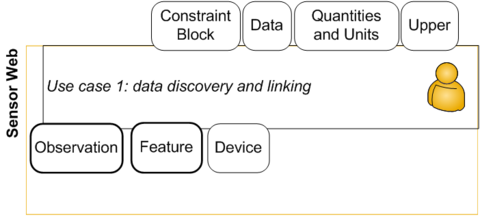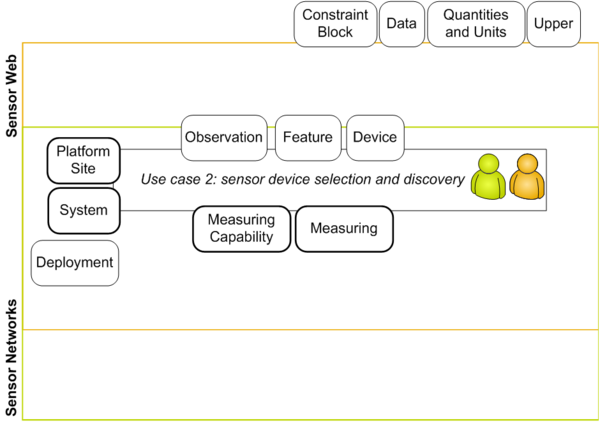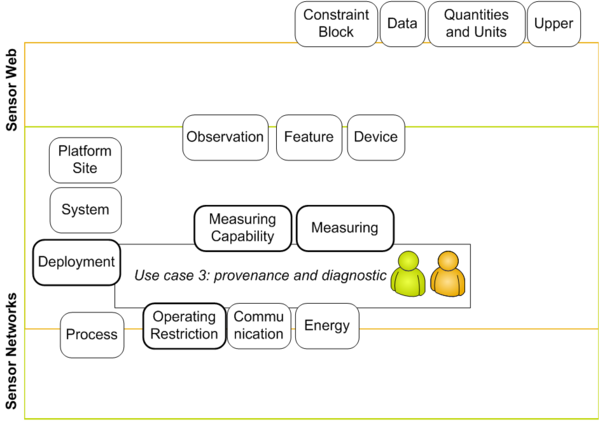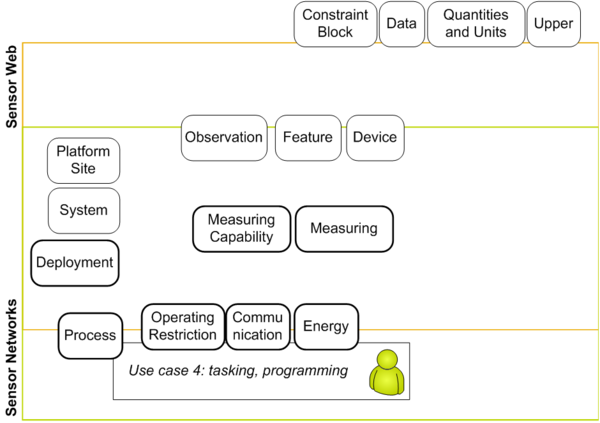Warning:
This wiki has been archived and is now read-only.
Ontology modules (rationale)
Contents
Defining Ontology modules
Pass 1
Following the agreed process for the development of the ontology, after the device ontology review and assessment of existing sensor ontologies, we now have to identify the bits that are missing or need revision.
The Key Sensor Concepts page describes the current structure of the sensor ontology and its central concepts. There are references like the MMI facet list and the SANY sensor taxonomy that give other perspectives on what a sensor ontology should cover -- see also SensorML and O&M.
This table is a condensed version of the extended minutes from our device ontology review. Members of the group can identify package(s) they're interested working on and enter their name in the "Who's doing it?" column. The "Use case(s)" column is meant to narrow the scope of the package.
The amount of work per package isn't equal; some are actually quite large while others are just have a look at something and add a couple of concepts to the ontology.
This is a work in progress - this table is being refined and updated, as is the design of what should be included.
| Concepts for | Scope of this | Use case(s) | Who's doing it? ! | |
|---|---|---|---|---|
| 1 | values and ranges | has links into anything that requires a value and a unit | ... | Michael and Holger |
| 2 | UoM, time, location, platform | should all probably be external, but what are the right things | ... | TBD |
| 3 | Mobility, In-situ-/remote-sensing and field of sensing | describing where a sensor senses, how it can move and how it can change its field of sensing | ... | TBD |
| 4 | System structure | sensors, components, systems etc, including granularity of sensors and processes. Note the difference in basic structure between for example the CSIRO, MMI and OOTethys ontologies | ... | TBD |
| 5 | Observation, Phenomenon, Measurement | see discussion from recent weeks, how to align sensors and observations | ... | TBD |
| 6 | Operational/survival range and restrictions | battery life, maintenance schedule, lifetime of device, on what and where can it be deployed, storage/processing capacity | ... | TBD |
| 7 | calibration | ... | ... | TBD |
| 8 | operational availability | availability, functionality status, etc | ... | TBD |
| 9 | Metadata | manufacturing details, websites, identification | ... | TBD |
| 10 | Uncertainty/accuracy | ... | ... | TBD |
| 11 | Events | ... | ... | TBD |
| 12 | Sensor types | See A3ME and OntoSensor for examples | ... | TBD |
| 13 | history | of deployment, configuration, operating conditions, etc | ... | TBD |
Pass 2
Table 1 - Groups and sub-groups of concepts
- Table below based on pass 1 and on the categories from the Compton et al 2009 review paper allocated to the main groups described above (plus a 5th group for the rest and the imported ontologies)
| Groups | Sub-groups | Description |
|---|---|---|
| Sensor/Device | - | Sensor, systems, components and devices |
| System structure (components, deployment, configuration_ | Sensors, components, systems etc, including granularity of sensors and processes. | |
| Sensor types (sensor hierarchy) | See A3ME and OntoSensor | |
| History (history) | of deployment, configuration, operating conditions, etc | |
| Observation: O&M | ||
| Observation, Phenomenon, Measurement (data/observation, feature/quality, sampled medium) | how to align sensors and observations | |
| Capabilities | What the sensor measures, how accurately it measures, how often it can measure and the field of view | |
| Measurement Capabilities (response model) | What the sensor measures, how accurately it measures | |
| Mobility, In-situ-/remote-sensing and field of sensing (field of view/sensing) | describing where a sensor senses, how it can move and how it can change its field of sensing (including discussion on compatibility with platform ontology?) | |
| Operational availability | availability, functionality status, etc | |
| Operational/survival range and restrictions (operating conditions) | battery life, maintenance schedule, lifetime of device, on what and where can it be deployed, storage/processing capacity | |
| Uncertainty/accuracy (accuracy), Calibration | ||
| Process (action & process) | Inputs and outputs, procedure/functions, describe how a measurement is made and how sensors (and other systems) are combined together | |
| Action and process | ||
| Event | ||
| Imported ontologies (not sensor specific) | where the sensor is, where it is measuring, its power supply what it is attached to, its physical dimensions and weight, its operating conditions and who made it | |
| Values and ranges (dimension, weight, power supply, frequency) | has links into anything that requires a value and a unit | |
| UoM (units of measurement), time (time), location (location), platform (platform) | should all probably be external, but what are the right things | |
| Metadata (identity & manufacturing, contacting & software) | manufacturing details, websites, identification |
Pass 3 Groups and sub-groups
| Groups | Sub-Groups | Object | Description ! |
|---|---|---|---|
| Base | Data | Utilities to capture data | Data, Value (xsd:types), Interval |
| Base | UoM | Units and Quantities | Dimension, Unit of Measurement, (Physical) Quantity |
| Base | Time | Time | Time (absolute and relative) |
| Base | Location | Location and coordinate systems | Math and Geospatial defs (absolute and relative) |
| Base | DataQuality | Uncertainty, data quality factors | Characteristics of data, fitness to purpose (probability-based, other) |
| Base | Geometry | Basic geometrical concepts (static) | Any type of 2D or 3D objects |
| Base | SpatioTemporal | Basic geometrical concepts (dynamic) | Any type of 4D objects, including time series |
| Model | ConstraintBlock | Constraint, Condition (specification-form model) | (Simple or Complex) Condition, Constraint having an influence on something |
| Model | FunctionBlock | Function with inputs and outputs (solution-form model)) | A model |
| Model | Parthood | Aggregation, Compostion, Merology | Different sorts of has-part relationships for the concepts defined above |
| Model | System | System structure (components,configuration_ | Sensors, components, systems etc, including granularity of sensors and processes. |
| Model | Process | Process (action & process) | Inputs and outputs, procedure/functions, describe how a measurement is made and how sensors (and other systems) are combined together. See SensorML process, SysML and DAQ in NEESGrid. |
| Upper | Entity | Entity (tuple of attributes), Physical objects (tupleof observable attributes), Abstract Object | Anything: real, possible, or imaginary, which some modeller wants to talk about for some purpose. (DUL). Anything that is defined by its properties. |
| Upper | Upper | Upper classes (branches): main top classes and the relations between them | Event, Agent (anything to import from DOLCE) |
| Upper | ArtifactFunction | Upper functions: Artifact functions | High level principles (including actuators and sensors functions). Inlcuding Stimuli stuff for observationsand other relevant definitions from Garbacz, P. 2006. Towards a standard taxonomy of artifact functions. |
| Deploy | PlatformSite | Platform, Site | Container for all siting and mobility specific characteristic |
| Deploy | PlatformSite | Platform, Site functions | Functions for all types of platforms, sites |
| Deploy | PlatformSite | Platform, Site properties | Properties for all types of platforms, sites (see FGDC Remote Sensing metadata) |
| Deploy | PlatformSite | Platform, site capabilities | |
| Deploy | PlatformSiteRestriction | Site or platform-related operational/survival range and restrictions (perating conditions) | Ability of the platform to reach, maintain itself at the right point for sensing |
| Deploy | PlatformSiteType | Site and platform types (hierarchy) arranged in function of their siting and mobility-specific capabilities | May have multiple sub-hierarchies in function of domais e.g. MMI platform ontology, Stream gages siting configuration (GSDQ), … |
| Deploy | DeviceSupport | Device relation to other objects, especially platform | On what and where can it be deployed. How a device can be related to a site or to a platform (overlap with system structure, configuration) |
| Deploy | Deployment | Deployment (deployment, configuration) | See definitions in NEESGRID |
| Deploy | DeploymentRestriction | Operational/survival range and restrictions (operating conditions) - operational availability | Maintenance schedule, lifetime of device, platform, |
| Deploy | DeploymentMetadata | Who is doing the deployment, for what reasons (experimentation) | See definitions in NEESGRID |
| Deploy | DeploymentType | Platform, Site, Deployment types (hierarchy) arranged in function of characteristics | If needed (corresponds to scientific experiment templates). May overlap with other hierarchies (should be inferrred - not hard-coded) |
| Device | Device | Device | Container for all device specific characteristic |
| Device | Device | Device function | See Artifact functions and also primary and secondary equipment functions in NEESGrid |
| Device | Device | Device properties characterising the ability of the device to perform its function | availability, functionality status, |
| Device | Device | Properties (dimension, weight) | Properties for all types of devices |
| Device | DeviceType | Device types (hierarchy) arranged in function of the type of functions they perform | May overlap with other hierarchies (should be inferrred - not hard-coded) |
| Device | DeviceMetadata | Metadata (identity & manufacturing,contacting & software) | manufacturing details, websites, identification |
| Energy | Energy | Energy device | Container for all energy specific characteristic |
| Energy | Energy | Energy function | Whether the device can generate energy or consume energy or both (describe the energy flow) |
| Energy | Energy | Energy properties (power supply) | Properties for devices requiring an energy source |
| Energy | EnergyRestriction | Operational/survival range and restrictions (operating conditions) for energy management | battery life, |
| Energy | EnergyDeviceType | Energy device types (hierarchy) arranged in function of their energy characteristics | May overlap with other hierarchies (should be inferrred - not hard-coded) |
| Communication | Communication | Communication device | Container for all communication specific characteristic |
| Communication | Communication | Communication function | Whether the device can send or receive data, messages, information or both |
| Communication | Communication | Communication properties (frequency, throughput) | Properties for communication devices (overlap with system?) |
| Communication | CommunicationRestriction | Operational/survival range and restrictions (operating conditions) for communication | Factors limiting the ability of the device to communicate |
| Communication | CommunicationDeviceType | Communication device types (hierarchy) arranged in function of their communication characteristics | May overlap with other hierarchies (should be inferrred - not hard-coded) |
| Processing | Processing | Processing device | Container for all data processing specific characteristic |
| Processing | Processing | Processing function | Whether (and how) the device can process information |
| Processing | Processing | Data processing properties (e.g. computing power) | Properties for processing devices (overlap with system?) |
| Processing | ProcessingRestriction | Operational/survival range and restrictions (operating conditions) for processing | Factors limiting the ability of the device to process information: storage/processing capacity |
| Processing | ProcessingDeviceType | Processing device types (hierarchy) arranged in function of their data processing characteristics | May overlap with other hierarchies (should be inferrred - not hard-coded) |
| Sensor | Measuring | Measurement (device), Sensing device, Sensor | Container for all sensing/measurement specific characteristic |
| Sensor | Measuring | Physical principles (response model) on which the sensor is based | What the sensor measures (generic defs) - check the overlap with Observation |
| Sensor | SamplingCapability | Spatio-temporal capabilities of the sensor (field of view, rate of sampling) | How often it can measure, the field of view - check the overlap with Observation |
| Sensor | MeasuringCapability | Properties of measuring devices (accuracy, resolution, …) | How the sensor measures (what characterises its performance) |
| Sensor | MeasuringRestriction | Measuring range and restrictions | What impact the ability of a sensor to measure something |
| Sensor | MeasurementDeviceType | Sensor types (sensor hierarchy) arranged in function of the type of measurement they perform | What the sensor measures (domain-dependent defs). See A3ME and OntoSensor. Overlap with other hierarchies (should be inferrred - not hard-coded) |
| Sensor | Calibration | Calibration | TBD |
| Observation | Observation | Observation, Phenomenon, Measurement (data/observation,feature/quality, sampled medium) | Container for observation characteristic (projection into O&M) |
| Observation | Procedure | Procedure | Method used to do the observation |
| Observation | SampledFeature | Sampled feature | As defined by O&M |
| Observation | ObservationMedium | Observation Medium (sampled medium) | As defined by O&M |
| Observation | ObservationSpecimen | Observation Specimen | As defined by O&M |
| Observation | SamplingFeature | Sampling feature | As defined by O&M (see also NEESGRID) |
| Observation | ObservationMetadata | Metadata | What is not specified elsewhere |
| Dataset | Dataset | Dataset | Container for all dataset specific characteristic. See Information object in DOLCE, digital library defs, SERONTO |
| Dataset | GeospatialDataset | Observation data | Container for O&M/SOS (results) |
| Dataset | GeospatialDataset | Geographic feature data | Container for feature characteristic (projection into GML) |
| Dataset | DatasetMetadata | All the information provided in the header or registry of a datasest and not listed above | Especially provenance, preservation/archive |
| Dataset | DeploymentDataset | Deployment (System + space/time variable configuration) = history (history) | of deployment, configuration, operating conditions, etc |
Pass 4 SSN Ontology
Some changes to the ontology split into "modules" have been made during the final phase of development to match the documentation page structure and the scope of the examples supplied by the XG participants.
See the page introducing the Ontology structure.
The table below lists for each sections and modules:
- the initial discussions about it (when available)
- the documentation page for the module
- the examples page for the module
Modules and Mapping to use cases
A set of use cases have been identified as motivational use cases for the work that has been done in the context of this group. They can be roughly classified into four main groups, according to the following two axes:
1) User classification: from users who directly manage sensors and sensor networks; through to users who use and manipulate data (but may not have any direct interest in sensors).
2) Technology: from Semantic Web through Sensor Web to Sensor Network.
The following table and figures provide different viewpoints on this classification, providing names for these four groups of use cases (data discovery, device discovery and selection, provenance and diagnosis, and device operation tasking and programming). The reason to identify several use case categories is that each one requires different levels of detail for the modelling of the sensors, the features they observe, their capabilities, their environment and their conditions of use. These use cases will be described next.
| Use Case Class | Short Description |
|---|---|
| 1. Data Discovery and Linking | Find all observations that meet certain criteria, and possibly link them to other external data sources. The user may use different criteria to select the area and window to be considered in the spatio-temporal constraint, or the user may select specific types of constraints in terms of the types of observations to be found, and may relate the results obtained with external data sources. |
| 2. Device Discovery and Selection | Find all the devices that meet certain criteria. The criteria can be something like type, geographic region, measured phenomenon, range of measurement, availability, owner/responsible party, manufacturer etc. and also combinations of those. |
| 3. Provenance and Diagnosis | Provide extra information about the instrument to better evaluate or process the data |
| 4. Device Operation Tasking and Programming | Command a device's operation using its description and information on its conditions of use |
The figures below illustrates which modules are more important for each category of use cases defined above.
Use Case 1: Data discovery and linking
Comment: there are many ways to find the datasets containing the right observations. Some discovery strategies, via the features or the observed properties are less dependent on sensor-related knowledge.
Use Case 2: Sensor device selection and discovery
Comment: in this use case, measuring capabilities are more important to identify the sensing assets.
Use Case 3: Provenance and diagnosis
Comment: operational restrictions become more important, especially the ones which impact sensor performances.
Use Case 4: Tasking, programming
Comment: to operate sensors and sensor networks, it is important to better manage the environmental conditions and system features more generally and to know what are the communications or the energy requirements for each sensors.
